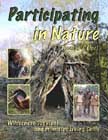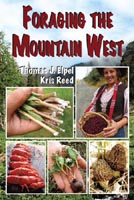St. Johnswort
(Hypericum perforatum) St. Johnswort Family
By Thomas J. Elpel with additions by Pamela G. Sherman
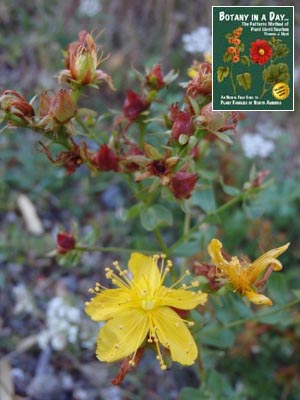
About St. Johnswort: If you've been troubled by depression then you may be delighted to learn about St. Johnswort. St. Johnswort has become a well-known and effective herbal alternative to Prozak and other anti-depressants. These are perennial herbs with simple, opposite leaves. The leaves are often covered with dark glands or clear dots. The petals are usually yellow, but may be tinged with red or orange spots. At least one species has pink blossoms. The flowers are regular and bisexual with 4-5 sepals, 4-5 petals, and 10 or more stamens.
Worldwide there are about 350 species of Hypericum including 25 species in North America. St. Johnswort (Hypericum perforatum), also known as klamath weed or goat weed, was introduced to this country in 1696 for it's medicinal, ornamental, and "magical" properties. Today the plant is found in most states, with 500,000 acres just in Montana. It is reported to be "cyclic" with significant population swings from year to year. St. Johnswort is a perennial plant with a horizontal spreading root system. It reproduces by both seeds and runners. A single plant may generate 15,000 to 30,000 seeds per year. Seeds remain viable in the soil for up to 10 years. Seed germination is inhibited during hot dry summers or when buried more than 2 mm below the surface.
Medicinal: In recent years St. Johnswort has become widely known for its medicinal value as an antidepressant. The primary active constituent is a pigment in the leaves and flower dots called hypericin. It is considered an herbal replacement for Prozak. In 1994 alone, St. Johnswort was prescribed for 20 million people in Germany--accounting for more than half of the prescriptions for mild to moderate depression. The herb is becoming more and more popular in this country as well.
A tea of the plant is antispasmodic, nervine, expectorant, astringent and diuretic. It is used for nervous conditions such as insomnia and bed-wetting. St. John's Wort has been demonstrated to significantly increase the healing of burns. Internal use of the plant may cause temporary sensitivity to intense sunlight.
 Common St. Johnswort has been used in the treatment of wounds for ages; its first recorded use was at the time of Dioscorides [40-90 AD]. and it has continued a main medicinal herb, mentioned in ancient England and Native American accounts. [Mitich]
Common St. Johnswort has been used in the treatment of wounds for ages; its first recorded use was at the time of Dioscorides [40-90 AD]. and it has continued a main medicinal herb, mentioned in ancient England and Native American accounts. [Mitich]
Per National Geographic: "Today, St. John's wort is possibly the most studied of all medicinal herbs...The Greeks used St. John's wort to treat melancholy as well as insanity...Modern scientific studies have shown that the extract actually does affect the brain in a manner similar to a mild antidepressant...St. John's wort has anti-inflammatory and antiviral properties and is also known to help digestion, support the thyroid, and gently balance the neurotransmitters GABA, norepinephrine, serotonin, and dopamine. One major constituent of the plant is a chemical called hyperforin, which researchers feel might be useful in the treatment of alcoholism. Additional studies...are still required. Extracts of the herb are sometimes used as a topical remedy for wounds, abrasions, burns, and muscle pain. The flowers are rich in hypericin, a flavonoid that improves venous-wall strength, making them useful in treating swollen veins, bruising, or injury to the skin or muscles..." [Hajeski pp. 158-9]
People are cultivating St. Johnswort as a crop in some locations, even while it grows out of control in others. Wild-crafting has the potential to become one of the best controls to keep St. Johnswort population in check. Legislation should be considered to ban cultivation of St. Johnswort until all wild stands are utilized. It may also be worthwhile to divert funds that are currently spent on herbicides to be used instead to subsidize wild-crafters to harvest the medicinal plant. Wild-crafters need to determine harvest methods that kill the plant, to start reducing the population of this invasive plant.
 Mechanical Controls: Hand-pulling St. Johnswort just once may stimulate the plant to spread faster via its horizontal runners. However, you can control small infestations by repeatedly hand-pulling or digging the site a couple times a year over a number of years. Mowing has little effect on existing plants, but may reduce seed production. Burning favors the further spread of St. Johnswort.
Mechanical Controls: Hand-pulling St. Johnswort just once may stimulate the plant to spread faster via its horizontal runners. However, you can control small infestations by repeatedly hand-pulling or digging the site a couple times a year over a number of years. Mowing has little effect on existing plants, but may reduce seed production. Burning favors the further spread of St. Johnswort.
It's crucial to plant competing desirable species after digging. If the ecological niche remains unfilled, St. Johnswort can easily come back or the space may be filled by other plants you don't want. If native species are desired, they must be good competitors. [U.S. Forest Service]
Biological controls: Several insects have been introduced to dampen the spread of St. Johnswort, including a moth that eats foliage and flowers (Aplocera plagiata), a root-boring beetle (Agrilus hyperici), a midge which forms galls in the leaf buds (Zeuxidiplosis giardi), and foliage feeding beetles (Chrysolina hyperici & C. quadrigemina). Insect control with this latter beetle has proved very effective at the National Bison Range near Moiese, Montana, with moderate control every fifth year and major control every tenth year. The beetle population builds up over time, until the insects consume all new growth on the plants and eventually devour the stems. There were 8,000 acres of Saint Johnswort on the Bison Range in 1994, but only 400 acres by 1997. This biocontrol project saved an estimated $400,000 compared to herbicide applications.
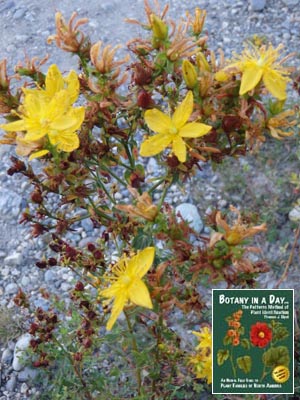 Grazing: St. Johnswort presents difficult problems for grazing, given its chemical constituents. It depresses the central nervous system and increases the animals' sensitivity to temperature change and handling. St. Johnswort also affects the liver, causing temporary sensitivity to sunlight. Livestock usually avoid it unless food is scarce. Excess consumption leads to blistering and itching on light-haired or unpigmented skin areas including the mouth, nose and ears. Dark skin is not affected. The animals may lose weight, become difficult to manage, and they may die of dehydration or starvation if there is swelling or soreness in the mouth. Cattle need to ingest only 1% of their body weight to be affected, whereas sheep can consume up to 4% of their weight. The wool and meat of affected animals is often of poor quality. Horses, rabbits and pigs are also affected by the herb, but I have not found any information reporting whether or not goats are affected. The dried plant as found in hay is much less potent than fresh, but may still cause problems.
Grazing: St. Johnswort presents difficult problems for grazing, given its chemical constituents. It depresses the central nervous system and increases the animals' sensitivity to temperature change and handling. St. Johnswort also affects the liver, causing temporary sensitivity to sunlight. Livestock usually avoid it unless food is scarce. Excess consumption leads to blistering and itching on light-haired or unpigmented skin areas including the mouth, nose and ears. Dark skin is not affected. The animals may lose weight, become difficult to manage, and they may die of dehydration or starvation if there is swelling or soreness in the mouth. Cattle need to ingest only 1% of their body weight to be affected, whereas sheep can consume up to 4% of their weight. The wool and meat of affected animals is often of poor quality. Horses, rabbits and pigs are also affected by the herb, but I have not found any information reporting whether or not goats are affected. The dried plant as found in hay is much less potent than fresh, but may still cause problems.
Chemical Controls: St. Johnswort can be difficult to kill with herbicides, due to its extensive root system. Uptake of the herbicides may also be limited because the leaves are small and waxy. Spotted knapweed is comparatively much easier to control. In places where the two weeds grow together I have observed that herbicides eliminate the knapweed, but allow the St. Johnswort to spread and fill the void. Control is possible with repeated applications of 2,4-D during the seedling and pre-bloom stages. Picloram (Tordon® 22K-spring) or metsulfuron (Escort®-on active growth) are also effective. Glyphosate (Roundup®) is effective, but also non-selective, so it will kill everything else too.
Important: Most "weed problems" are really "people problems" from poor land management and a lack of ecological insight. It is easy to reach for a tool like fire, mowing, or herbicides to attack an out-of-control weed, but often those tools do little to get to the root cause of the weed infestation, and sometimes make the problems worse. Please read more about range ecology, desertification, and invasive weeds on this website before applying any tool of weed control Go to: Desertification and Invasive Weeds.
Notes
- Thomas J. Elpel. Botany in a Day. HOPS Press: Pony, MT. January 2000.
- _____. "St. John's-wort". http://www.holoweb.com/cannon/stjohns.htm
- Don Ollsin. "St. Johnswort (Hypericum perforatum)". http://www.drwnet.com/wings/stjohn.htm.
- _____. "Hypericum perforatum L." An Assessment of Exotic Plant Species of Rocky Mountain National Park. Northern Prairie Wildlife Research Center: http://www.npwrc.usgs.gov/resource/othrdata/Explant/hypeperf.htm.
- Jane Krueger. "St. Johnswort's Drawback." The Montana Pioneer. No date available.
- Bret E. Olson and John R. Lacey. "Sheep: A Method For Controlling Rangeland Weeds." Sheep Research Journal. Special Issue: 1994. Pages 105-112.
- _____. 1997-1998 Montana - Utah - Wyoming Weed Management Handbook. Extension Services: MSU, USU, UW. Pages 258-259.
- U.S.Forest Service: St. Johnswort monograph: http://www.fs.fed.us/database/feis/plants/forb/hypper/all.html.
- Larry Mitich: St. Johnswort monograph in http://wssa.net/weed/intriguing-world-of-weeds/#x.
- Nancy Hajeski, Complete Guide to Herbs and Spices. National Geographic Washington DC.
Return to the Weed Profiles Table of Contents
Return to the Wildflowers & Weeds Home Page.
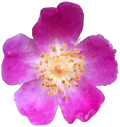



 Common St. Johnswort has been used in the treatment of wounds for ages; its first recorded use was at the time of Dioscorides [40-90 AD]. and it has continued a main medicinal herb, mentioned in ancient England and Native American accounts. [Mitich]
Common St. Johnswort has been used in the treatment of wounds for ages; its first recorded use was at the time of Dioscorides [40-90 AD]. and it has continued a main medicinal herb, mentioned in ancient England and Native American accounts. [Mitich] Mechanical Controls: Hand-pulling St. Johnswort just once may stimulate the plant to spread faster via its horizontal runners. However, you can control small infestations by repeatedly hand-pulling or digging the site a couple times a year over a number of years. Mowing has little effect on existing plants, but may reduce seed production. Burning favors the further spread of St. Johnswort.
Mechanical Controls: Hand-pulling St. Johnswort just once may stimulate the plant to spread faster via its horizontal runners. However, you can control small infestations by repeatedly hand-pulling or digging the site a couple times a year over a number of years. Mowing has little effect on existing plants, but may reduce seed production. Burning favors the further spread of St. Johnswort.  Grazing: St. Johnswort presents difficult problems for grazing, given its chemical constituents. It depresses the central nervous system and increases the animals' sensitivity to temperature change and handling. St. Johnswort also affects the liver, causing temporary sensitivity to sunlight. Livestock usually avoid it unless food is scarce. Excess consumption leads to blistering and itching on light-haired or unpigmented skin areas including the mouth, nose and ears. Dark skin is not affected. The animals may lose weight, become difficult to manage, and they may die of dehydration or starvation if there is swelling or soreness in the mouth. Cattle need to ingest only 1% of their body weight to be affected, whereas sheep can consume up to 4% of their weight. The wool and meat of affected animals is often of poor quality. Horses, rabbits and pigs are also affected by the herb, but I have not found any information reporting whether or not goats are affected. The dried plant as found in hay is much less potent than fresh, but may still cause problems.
Grazing: St. Johnswort presents difficult problems for grazing, given its chemical constituents. It depresses the central nervous system and increases the animals' sensitivity to temperature change and handling. St. Johnswort also affects the liver, causing temporary sensitivity to sunlight. Livestock usually avoid it unless food is scarce. Excess consumption leads to blistering and itching on light-haired or unpigmented skin areas including the mouth, nose and ears. Dark skin is not affected. The animals may lose weight, become difficult to manage, and they may die of dehydration or starvation if there is swelling or soreness in the mouth. Cattle need to ingest only 1% of their body weight to be affected, whereas sheep can consume up to 4% of their weight. The wool and meat of affected animals is often of poor quality. Horses, rabbits and pigs are also affected by the herb, but I have not found any information reporting whether or not goats are affected. The dried plant as found in hay is much less potent than fresh, but may still cause problems. 


